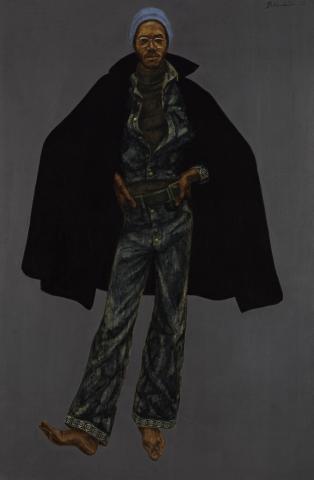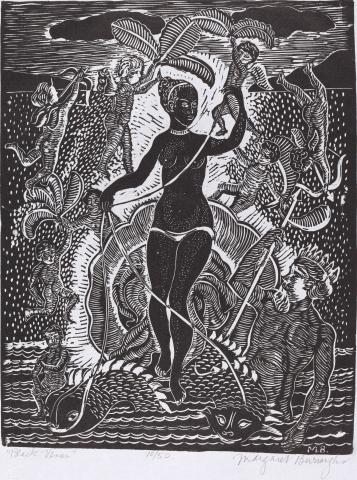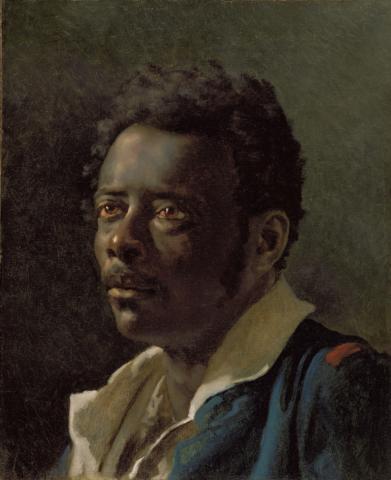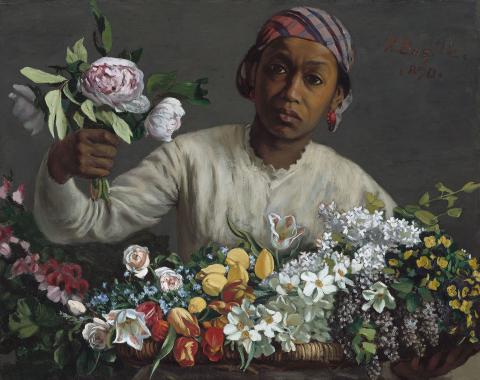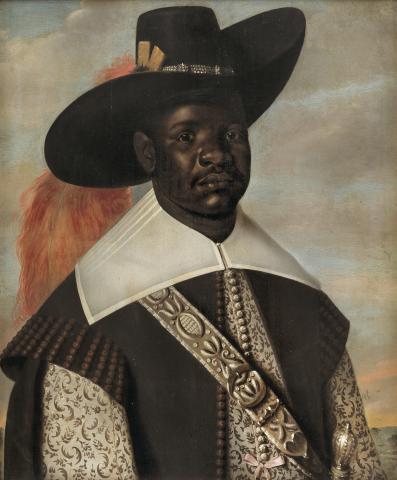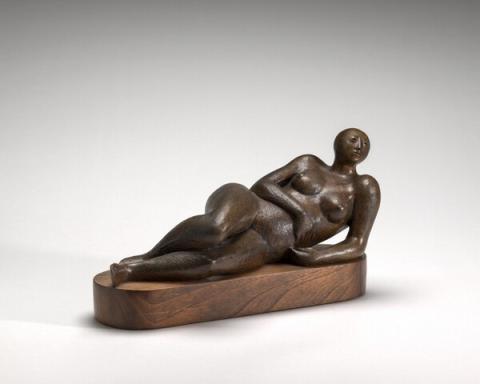Afro Atlantic Art: Portraits
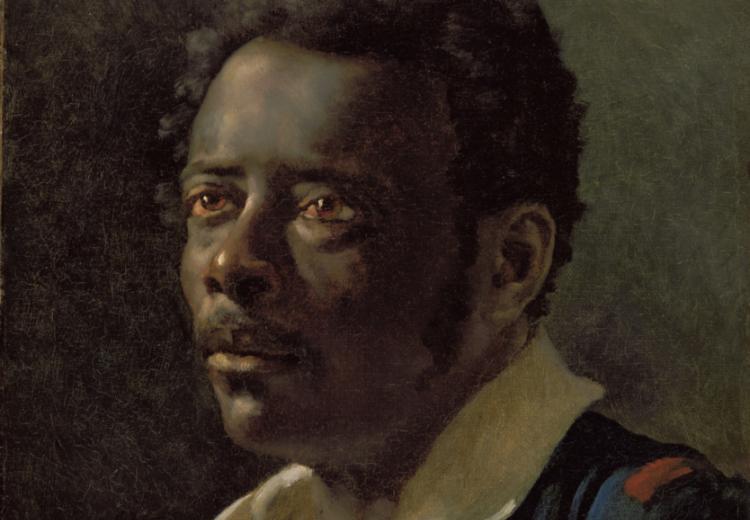
Théodore Géricault, Study of the Model Joseph, 1818–1819
Courtesy National Gallery of Art
This resource, provided courtesy of the National Gallery of Art, presents a variety of artworks, from the 17th century to the present, that highlight the presence and experiences of Black communities across the Atlantic world (the relationships between people of the Americas, Africa, and Europe). Use the portraits in this collection to engage your students in conversation about the many interpretations of Black identities.
Find related artwork and activities in the EDSITEment Teacher's Guide Arts of the Afro Atlantic Diaspora.
Barkley Leonnard Hendricks, George Jules Taylor, 1972
Barkley Leonnard Hendricks, George Jules Taylor, 1972, oil on canvas, National Gallery of Art, Washington, William C. Whitney Foundation, 1973.19.2
This life-size portrait depicts a young, gay Black man with a sense of confidence and style. As an artist and educator, Hendricks was keenly aware that the history of European and North American art largely omitted Black and brown subjects—a gap the artist addressed by making various members of his community the focus of his paintings. Hendricks depicts Taylor, a fellow student at Yale University, in a contrapposto stance, hands on his hips and weight resting on one leg, reclaiming a posture commonly associated with individuals in positions of power, such as gods or members of the aristocracy, in the classical tradition of portraiture.
Hendricks grew up in north Philadelphia in the 1950s and 1960s as the civil rights movement grew across the United States. His paintings and photographs convey a sense of individuality, and his work ranges from depictions of everyday people to images of well-known contemporary figures, such as jazz musicians Miles Davis and Charles Mingus.
- What words would you use to describe the individual in this painting?
- If you could choose someone from your community to create a portrait of, who would you choose and why?
Margaret Burroughs, Black Venus, c. 1957
Margaret Burroughs, Black Venus, c. 1957, linocut, National Gallery of Art, Washington, Reba and Dave Williams Collection, Florian Carr Fund and Gift of the Print Research Foundation, 2008.115.29
In this linocut print, artist Margaret Burroughs responds to a 1793 work by Thomas Stothard called Voyage of the Sable Venus from Angola to the West Indies. Also a reference to Botticelli’s Renaissance painting The Birth of Venus, Burroughs’s print—made during the civil rights movement—positions a Black subject as the goddess of love, affirming the beauty and power of Black women. In addition to her artistic practice, Burroughs was an activist, educator, and fixture of Chicago’s South Side community, founding the South Side Community Art Center and the DuSable Museum.
The print’s title, Black Venus, also recalls one of the terms historically used to describe Saartjie “Sara” Baartman, an 18th-century South African woman who was exploited for public display in Europe.
- Why do you think Burroughs chose to recreate Stothard’s print?
- How do the two prints differ in detail and point of view?
Théodore Géricault, Study of the Model Joseph, 1818–1819
Théodore Géricault, Study of the Model Joseph, 1818–1819, oil on canvas, The J. Paul Getty Museum, Los Angeles, 85.PA.407
Théodore Géricault painted this portrait of a model in preparation for his most famous painting, The Raft of the Medusa. The model, Joseph, was a Haitian man who came to Paris with an acrobat troupe. After working with Géricault, he became a sought-after model.
This intimate study of a single figure provides an emotional look at a Black subject during a time of slavery and its atrocities. The several colors blended to depict his complexion show he was painted with great care, of a level not usually given to Black subjects at the time. While the painting is of Joseph, he was standing in for the role of a victim of the Medusa shipwreck.
The Medusa was a French ship that ran aground en route to Senegal on a mission to secure French rule over the colony and maintain the slave trade there; a shortage of lifeboats meant that only about 10 out of 150 passengers survived. Géricault’s painting of the real-life event included depictions of Black figures within the gruesome scene.
- What emotions do you feel when you look at this portrait?
- Learn more about Géricault’s artistic interpretation of the Medusa shipwreck from NEH-supported Smarthistory. Why is this painting considered radical?
Frédéric Bazille, Young Woman with Peonies, 1870
Frédéric Bazille, Young Woman with Peonies, 1870, oil on canvas, National Gallery of Art, Washington, Collection of Mr. And Mrs. Paul Mellon, 1983.1.6
In this portrait, French artist Frédéric Bazille presents a young Black woman, a vendor of flowers, gazing directly at the viewer. This painting conveys a sense of the woman’s individuality, with close detail given to her facial expression and her dress. Bazille lived in an area of Paris where freed Black Parisians had established communities after the abolition of slavery in 1848, and he may have encountered people like the woman depicted here in his everyday life. While Black individuals may have had free status in France in the late 19th century, many still struggled to find the same opportunities for employment and advancement available to white citizens.
- What do you imagine this woman might be thinking? What details help you draw this conclusion?
- What questions would you want to ask her?
Unknown Dutch, Dom Miguel de Castro, Emissary of Kongo, 1640–1644
Unknown Dutch, Dom Miguel de Castro, Emissary of Kongo, 1640–1644, oil on panel, Statens Museum for Kunst (SMK), National Gallery of Denmark, Copenhagen
Dom Miguel de Castro was an envoy from the Kingdom of Kongo (a region covering the modern-day nations Angola and Democratic Republic of the Congo) to the Dutch court in Recife, Brazil. Castro was heavily involved in peace negotiations between the Dutch and the Kingdom of Kongo while Portuguese enslavement in the area intensified in the 17th century. The Kingdom of Kongo persisted until a revolt against Portuguese rule in 1914, at which point the region was absorbed into the Portuguese colony of Angola.
This portrait of Castro is part of a group of three; the other two are smaller and portray his servants Diego Bemba and Pedro Sunda. In this painting, the artist depicts Castro with elaborate European clothing and accessories, reinforcing his position of power as a key player in diplomatic affairs.
- What words would you use to describe this individual? What makes you say that?
- How might this image contribute to contemporary understandings of the relationships between nations in Africa and European colonizers?
Mickalene Thomas, Melody: Back, 2011
Mickalene Thomas, Melody: Back, 2011, diffusion transfer print (Polaroid), National Gallery of Art, Washington, Charina Endowment Fund and Peter Edwards and Rose Gutfeld Fund, 2020.3.1
This photograph recreates a famous 19th-century painting, The Grand Odalisque, by French artist Jean-Auguste-Dominique Ingres. The “odalisque” pose, a recurring scene in French painting, typically portrayed European fantasies of non-European women amid lush settings and objects that alluded to cultures outside of Europe. These odalisque paintings were created at a time when France was expanding its colonial empire, largely in North and West Africa.
Here, the artist Mickalene Thomas portrays her subject in a position where the phrase “only God can judge me” is visible as a tattoo on her lower back, the words reasserting control over portrayal of the Black body.
- How does this image compare to both historical and contemporary portrayals of Black women?
- Who seems to be in control—the subject, the photographer, or the viewer? What details help you draw this conclusion?
Elizabeth Catlett, Reclining Female Nude, 1955
Elizabeth Catlett, Reclining Female Nude, 1955, bronze, National Gallery of Art, Washington, Corcoran Collection (The Evans-Tibbs Collection, Gift of Thurlow Evans Tibbs, Jr.), 2014.136.296
Elizabeth Catlett dedicated her art to the African American experience. She believed that “art can prepare people for change; it can be educational and persuasive in people’s thinking.”
Catlett was born in Washington, DC, in 1915, but she moved to Mexico permanently in 1946 in response to the US government’s treatment of activists during the escalating Cold War. There, she studied sculpture and made prints with the Taller de Gráfica Popular (People’s Graphic Arts Workshop) and became the first woman sculpture professor at the Escuela Nacional de Artes Plásticas (National School of Plastic Arts).
In Reclining Female Nude, Catlett emphasizes the hips and breasts of her subject, contrasting them with the figure’s small and stylized head. The artist took inspiration from both African and Mexican sculpture and positioned her work in conversation with contemporary European artists such as Henry Moore and Constantin Brâncuşi.
- What details stand out to you about this sculpture?
- What words would you use to describe it?
- How might this sculpture “prepare people for change”?
This resource is drawn from the content of the Afro-Atlantic Histories exhibition organized by the Museum of Fine Arts, Houston, and the Museu de Arte de São Paulo in collaboration with the National Gallery of Art, Washington. All related materials found on EDSITEment have been provided courtesy of the National Gallery of Art, Washington.

